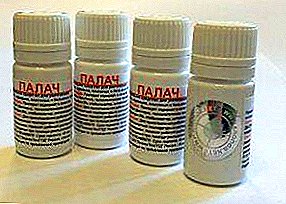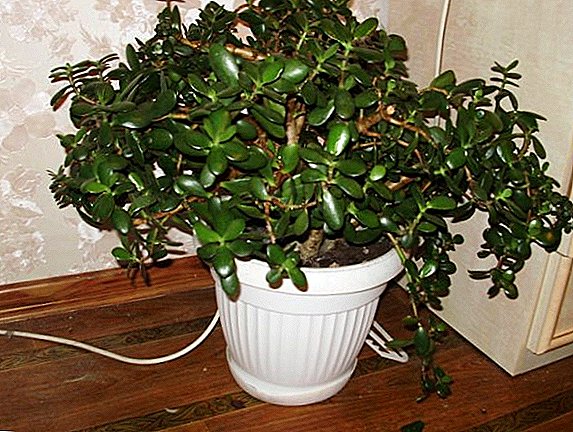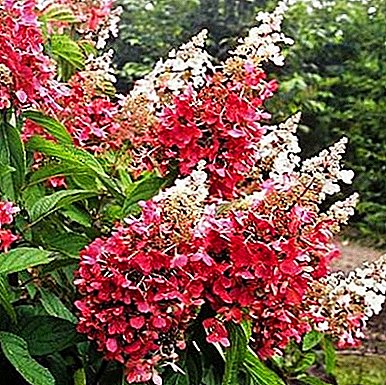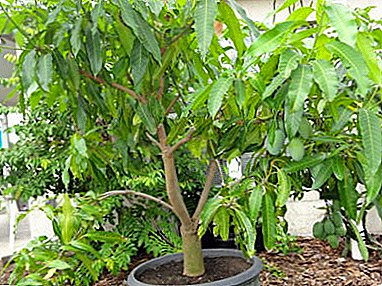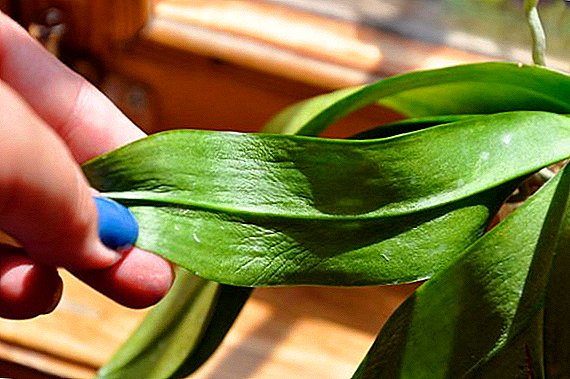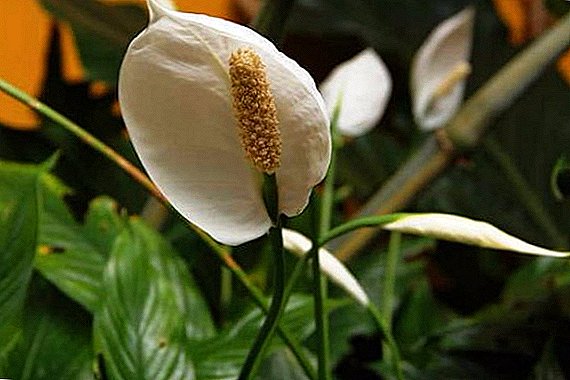 Wallis's Spathiphyllum, or "female happiness," refers to the family of the Aroids. There are more than 40 types of flower. Homeland plants - South America, East Asia, Polynesia, the island of New Guinea. In nature, an evergreen perennial grows on the banks of rivers, reservoirs. This article focuses on the cultivation of spathiphyllum and care for him at home.
Wallis's Spathiphyllum, or "female happiness," refers to the family of the Aroids. There are more than 40 types of flower. Homeland plants - South America, East Asia, Polynesia, the island of New Guinea. In nature, an evergreen perennial grows on the banks of rivers, reservoirs. This article focuses on the cultivation of spathiphyllum and care for him at home.
Botanical description
Spathiphyllum grows to 35-45 cm, but there are also dwarf perennials that have a height of 15-25 cm. "Female happiness" does not have a stem. Its basal leaves create a bundle right out of the ground. The plant has long oval or lanceolate leaves of dark green color, which are located on the petioles, extended at the base. Median vein clearly visible on leaflets. Rhizome short.  Tropical perennial flowers are very spectacular. The inflorescence has the shape of a cob, grows on a long stem, and has a white veil at the base. The first flowers are formed early - at the age of six months. Spathiphyllum blooms from early spring to early autumn, blooms for 1.5-2 months.
Tropical perennial flowers are very spectacular. The inflorescence has the shape of a cob, grows on a long stem, and has a white veil at the base. The first flowers are formed early - at the age of six months. Spathiphyllum blooms from early spring to early autumn, blooms for 1.5-2 months.
Did you know? The name "Spathiphyllum" is translated from Greek as follows: "spatha" is the coverlet, and "phyllon" is a sheet that describes the appearance of the flower.
Growing conditions
In nature, the flower grows in a tropical climate, so the house must create appropriate conditions for its growth.
Humidity and temperature
The best humidity for the Wallis spathiphyllum is not less than 40%. During the summer, the plant should be sprayed daily, and once every 14 days it is necessary to wipe the leaves from dust using a damp sponge.  In warm seasons, the temperature for growing should be + 18-23 ° C. In the autumn-winter period, it should not be lower than + 16 ° С. If it drops, the flower will develop more slowly. It is important to protect the tropical perennial from drafts.
In warm seasons, the temperature for growing should be + 18-23 ° C. In the autumn-winter period, it should not be lower than + 16 ° С. If it drops, the flower will develop more slowly. It is important to protect the tropical perennial from drafts.
Flower lighting
Considered perennial prefers bright but diffused light. The direct rays of the sun can leave burns on the leaves, so they are recommended to be avoided. The best place to grow it is the south window. Spathiphyllum cannot be placed in a dark room - its leaves can stretch out, and the plant itself will not be happy with flowering.
In addition to spathiphyllum, lovers of unpretentious indoor plants should pay attention to sansevieriya, chlorophytum, tradescantia, cacti, euphorbia, hoya, frostbite, hibiscus, Christmas tree.
Soil requirements
"Female" flower grows remarkably in light, loose and nutritious soil.  You can purchase a universal mixture, where peat is the fourth part of the total volume. To create a suitable substrate for the house spathiphyllum, you need to mix equal parts of peat, coarse sand, leaf earth and humus. In the resulting mixture is allowed to add sphagnum or vermiculite.
You can purchase a universal mixture, where peat is the fourth part of the total volume. To create a suitable substrate for the house spathiphyllum, you need to mix equal parts of peat, coarse sand, leaf earth and humus. In the resulting mixture is allowed to add sphagnum or vermiculite.
Care for the Wallis Spathiphyllum
Spathiphyllum is an unsightly flower. But so that he gives his white flowers at home, it is recommended to follow some care tips.
Watering
In warm seasons, when the spathiphyllum is actively growing, it is necessary to constantly keep the soil moist. In autumn and winter, water the flower should be less. The main thing is to prevent the substrate from drying out. In the summer it is recommended to water the plant 1 time in 2 days, and in winter - 1 time in 7 days. Tropical perennial should be moistened with separated soft water, which is at room temperature. 
Fertilizer
From March to September, the plant needs mineral supplements. The concentration should be weak - 1-1.5 g of fertilizer diluted in 1 liter of water. The procedure is carried out once in 3 weeks. Mineral fertilizers are recommended to alternate with a solution of mullein. Before and after the procedure, the flower is well watered. In winter, the spathiphyllum does not need fertilizing. Only in the case of flowering it should be fertilized once a month.
Transfer
A young flower must be replanted annually. From the age of four it is recommended to carry out the procedure once every 3 years. Replace need to carefully, as a tropical plant fragile roots. It is best to use the transshipment method without destroying the earthy lump.  The procedure is best done in the spring. The substrate should be loose and consist of equal parts of sand, peat, humus, turf and hardwood land. A pot for transplanting should be slightly larger than before. Drainage should be laid on the bottom.
The procedure is best done in the spring. The substrate should be loose and consist of equal parts of sand, peat, humus, turf and hardwood land. A pot for transplanting should be slightly larger than before. Drainage should be laid on the bottom. 
Important! The juice "female happiness" poisonous - it can cause local allergies and irritation of the skin. Therefore, after working with the flower must be thoroughly washed hands.
Flower reproduction
Spathiphyllum is propagated in the following ways:
- Seeds. This method takes a lot of time. Flower seeds quickly lose their germination, and because of this, the process is considered difficult. After pollination, the plants must wait for the seeds to ripen, then collect them and immediately plant. They are planted in a pot with moist soil (sand + peat) and placed in a heated (up to + 24 ° C) mini-greenhouse. To maintain substrate moisture, spray it regularly. The greenhouse needs to be constantly aired so that no mold forms on the surface and the seeds do not start to rot.
- Cuttings. The handle is a rosette, which is cut from an adult perennial. It is put in water for 15-20 days, until roots appear. To avoid rotting of the stem from below, it is recommended to add activated charcoal to the water - half a tablet per 1 cup of water. When the roots reach 2-3 cm, then the stalk is ready for planting in the soil.
- The division of the roots. This method is considered the simplest. When the roots are divided, the resulting bushes are already ready-made plants that can be immediately planted in the substrate. The procedure is carried out at a temperature of + 20 ° C. Before you get the mother flower from the pot, you need to water it well - so the roots feed on water and will break less.
 From the plant, which was separated, it is necessary to remove dry and rotten roots, sluggish leaves. A young flower is planted in a pot with a diameter of not more than 15 cm.
From the plant, which was separated, it is necessary to remove dry and rotten roots, sluggish leaves. A young flower is planted in a pot with a diameter of not more than 15 cm.


Did you know? Young couples often acquire a tropical perennial, believing that its energy will help to conceive and endure a healthy baby.
Features and possible difficulties
People who grow spathiphyllum at home can face various problems, diseases and pests of a flower:
- leaves turn yellow and wither. The reason for this may be drying the substrate in a pot. If spathiphyllum has yellow leaves, then the soil should be moistened more often so that it is completely softened. The volume of water used is recommended to be increased slowly, as a sharp transition from drought to strong irrigation is unacceptable;
- dry ends of the leaves. The cause of this problem is inappropriate primer. It can also occur due to direct sunlight, cold water irrigation, or low humidity. You can solve the problem by removing the flower from the bright sun. Also, it must be regularly sprayed or placed near the pot with a container of wet sand or expanded clay;
- the leaves turn black. This can occur due to an excess of moisture, which caused rotting of the roots. Also, this problem may be deficient in phosphate-nitrogen fertilizers or low air temperature. If the leaves have become black, then the spathiphyllum must be taken out of the pot, examined the roots, removed the rotten ones and planted the plant in another substrate. If you have acquired a black tint due to lack of nutrients, then you need to make in the soil complex fertilizers with a nitrogen content;
- spider mite This insect settles on the underside of the leaves and treats them with cobwebs - the leaves begin to dry. The flower should be sprayed with soapy water, before removing the web from the leaves with a damp sponge. If this method did not help, then insecticides should be used;
- aphid. This pest multiplies very quickly. Aphids settle on the underside of leaves and feed on plant sap. The result is dried, curled leaves. To destroy the pest, the flower is sprayed with a soap solution or a solution of nicotine sulfate (1 g per 1 l of water);
- schitovka. When this pest appears, the leaves of the spathiphyllum become covered with dark spots. To get rid of the insect, you must process the flower with soapy water, adding tobacco and kerosene to it. After this, the plant should be washed with a clean soap solution and sprayed with insecticides;
- mealybug. This pest can appear between the leaves due to strong moisture. If there are few insects, they can be cleaned with a sponge dipped in alcohol. If a lot, then for the treatment of plants it is recommended to use "Aktellik" or an infusion of citrus peel.



Important! It is necessary to process a flower accurately that insecticides did not get to soil. Otherwise it can lead to the death of the plant.If you provide high quality plant care, the unusual flower will thank you with beautiful flowering and bright green leaves. Also, "women's happiness" will provide peace of mind, harmony and contribute to the realization of desires.


 From the plant, which was separated, it is necessary to remove dry and rotten roots, sluggish leaves. A young flower is planted in a pot with a diameter of not more than 15 cm.
From the plant, which was separated, it is necessary to remove dry and rotten roots, sluggish leaves. A young flower is planted in a pot with a diameter of not more than 15 cm.